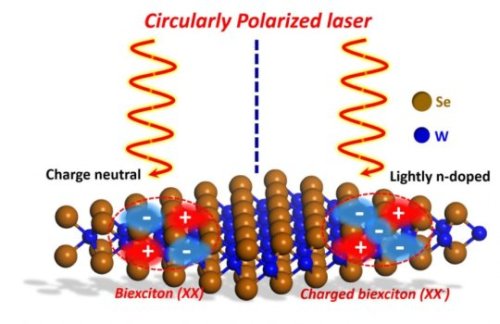#transition metal dichalcogenides
Novel monolayer ferroelectric hybrid structures
Scientists at the U.S. Naval Research Laboratory (NRL), Materials Science and Technology Division, have demonstrated that the intensity and spectral composition of the photoluminescence emitted from a single monolayer of tungsten disulphide (WS2) can be spatially controlled by the polarization domains in an adjacent film of the ferroelectric material lead zirconium titanate (PZT).
These domains are written in the PZT using a conductive atomic force microscope, and the photoluminescence (PL) is measured in air at room temperature. Because the polarization domain wall width in a ferroelectric can be as low as 1-10 nm, this approach enables spatial modulation of PL intensity and the corresponding carrier populations with potential for nanoscale resolution.
Single monolayer transition metal dichalcogenides (TMDs) such as WS2 exhibit striking optical properties due to their direct band gap. The dielectric screening is very low due to their two dimensional (2D) character, and thus their properties are strongly affected by their immediate environment, and can be modified and controlled by variations in local charge density due to adsorbates or electrostatic gating. This has generated keen interest in a wide variety of electronic and optical device applications.
Post link
Research on light-matter interaction could improve electronic and optoelectronic devices
Fundamental research sheds light on new many-particle quantum physics in atomically thin semiconductors
A paper published in Nature Communications by Sufei Shi, assistant professor of chemical and biological engineering at Rensselaer, increases our understanding of how light interacts with atomically thin semiconductors and creates unique excitonic complex particles, multiple electrons, and holes strongly bound together. These particles possess a new quantum degree of freedom, called “valley spin.” The “valley spin” is similar to the spin of electrons, which has been extensively used in information storage such as hard drives and is also a promising candidate for quantum computing.
The paper, titled “Revealing the biexciton and trion-exciton complexes in BN encapsulated WSe2,” was published in the Sept. 13, 2018, edition of Nature Communications. Results of this research could lead to novel applications in electronic and optoelectronic devices, such as solar energy harvesting, new types of lasers, and quantum sensing.
Shi’s research focuses on low dimensional quantum materials and their quantum effects, with a particular interest in materials with strong light-matter interactions. These materials include graphene, transitional metal dichacogenides (TMDs), such as tungsten diselenide (WSe2), and topological insulators.
Post link
Researchers observe electrons zipping around in crystals
The end of the silicon age has begun. As computer chips approach the physical limits of miniaturization and power-hungry processors drive up energy costs, scientists are looking to a new crop of exotic materials that could foster a new generation of computing devices that promise to push performance to new heights while skimping on energy consumption.
Unlike current silicon-based electronics, which shed most of the energy they consume as waste heat, the future is all about low-power computing. Known as spintronics, this technology relies on a quantum physical property of electrons – up or down spin – to process and store information, rather than moving them around with electricity as conventional computing does.
On the quest to making spintronic devices a reality, scientists at the University of Arizona are studying an exotic crop of materials known as transition metal dichalcogenides, or TMDs. TMDs have exciting properties lending themselves to new ways of processing and storing information and could provide the basis of future transistors and photovoltaics – and potentially even offer an avenue toward quantum computing.
For example, current silicon-based solar cells convert realistically only about 25 percent of sunlight into electricity, so efficiency is an issue, says Calley Eads, a fifth-year doctoral student in the UA’s Department of Chemistry and Biochemistry who studies some of the properties of these new materials. “There could be a huge improvement there to harvest energy, and these materials could potentially do this,” she says.
Post link



